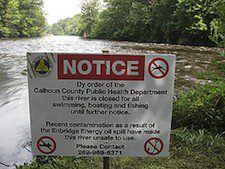 By Sarah Laskow, Media Consortium Blogger
By Sarah Laskow, Media Consortium Blogger
(reposted with permission)
BP is on the verge of escaping headlines, and if you’re ready to forget about the oil spill, fine. But disasters just like the Gulf spill are playing out across the country.
Yesterday, BP cemented the well that has been spewing oil into the Gulf of Mexico shut. The Obama administration is saying that the majority of the oil released is no longer a problem (ed. note: oh, really?). The spill was supposed to drive the Senate to finally pass a bill touching on energy issues and taking the oil industry to task, but this week Senate Majority Leader Harry Reid (D-NV) pushed back work on his minimalist energy bill until the fall.
But in states like Michigan and New York, similar stories are developing on smaller scales. For-profit companies, unburdened by strong regulations, are taking what they want, regardless of the consequences for the environment or for communities that depend on having clean soil, air, and water.
The last of the BP oil spill?
One hundred and eight days after the Deepwater Horizon rig exploded, it looks like oil will finally stop flowing into the Gulf. On Wednesday, the Obama administration released a report showing that much of the 5 million barrels of the spilled oil — three-fourths, even — had been collected, dispersed or evaporated.
By Thursday morning, those claims were already on thin ice, with some scientists saying the administration had rested its analysis on assumptions that would help them paint a rosy picture.
At Mother Jones, Kate Sheppard was skeptical from the get-go: “There’s still a lot of oil out there—about nine and a half Exxon Valdez spills in total,” she wrote. And much less than from three-quarters of the oil has disappeared. According to Sheppard’s reporting, “It’s actually closer to half. And, most importantly, the impacts of dispersing so much of that oil throughout the water column are still not well understood.”
Where did it all go?
In at least one case, it is painfully clear where the leftover oil has gone: Into communities populated by people of color. Michelle Chen reports at Colorlines:
We do know the destination of around 40,000 tons of the spill waste: it’s headed for the families that have been getting dumped on for years. In what may be yet another calm before the storm, BP’s colorfully advertised waste management plan appears to follow a haunting pattern of environmental racism.”
Chen gets her information from an analysis conducted by the Environmental Justice Resource Center at Clark Atlanta University. In essence, the study says, the dumping grounds to which BP is sending 61% of disposable oil spill waste are located in places where people of color make up the majority of the surrounding community.
Hullabaloo on the Kalamazoo
The repercussions of the BP spill may linger, but similar stories are playing out all the time. The clearest example right now comes from Michigan, where a faulty pipeline let almost one million gallons of oil spill into a tributary of the Kalamazoo River.
The spill may be the biggest in Midwest history, and at the Michigan Messenger, Eartha Jane Melzer is reporting that the company at fault, Enbridge Energy, has offered to buy houses along the affected stretch of river.
In Washington, a couple of Congressmen have begun sniffing around Enbridge’s practices. The Washington Independent’s Andrew Restuccia found that the Pipeline and Hazardous Materials Safety Administration, which is charged with overseeing the integrity of the pipelines carrying oil from place to place, is riddled with familiar rot. According to his report, the agency boasts both leaders who’ve been through the revolving door and a willingness to grant safety waivers that could put normal people in harm’s way.
The Kalamazoo spill has garnered additional attention due to the larger BP spill. But so far it looks like the company at fault will not have to face major consequences for its errors.
Frack that
Another example: The push for natural gas drilling is creeping eastward from Colorado and Wyoming to Pennsylvania and New York. As National Radio Project’s Making Contact explains, “While the BP oil spill has increased calls to use natural gas as a so-called ‘clean energy’ alternative, activists are sounding the alarm bell about this controversial gas drilling technique – hydraulic fracturing.”
In some places, “local groups aren’t waiting for federal regulation,” host Andrew Stelzer reports. “New York in particular is a hotbed of opposition.”
And indeed, AlterNet writes, the state senate in New York voted this week to wait on natural gas drilling. The state’s assembly must approve it, too, however. Like the oil spill in Michigan, like the BP oil spill, natural gas drilling is one more case where big energy companies are more concerned with profit than people—or the planet on which we live.
——————
This post features links to the best independent, progressive reporting about the environment by members of The Media Consortium. It is free to reprint. Visit the Mulch for a complete list of articles on environmental issues, or follow us on Twitter. And for the best progressive reporting on critical economy, health care and immigration issues, check out The Audit, The Pulse, and The Diaspora. This is a project of The Media Consortium, a network of leading independent media outlets.


